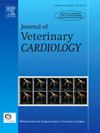Cerebral small vessel disease in a six-month-old Rottweiler with severe subaortic stenosis
IF 1.3
2区 农林科学
Q2 VETERINARY SCIENCES
引用次数: 0
Abstract
A six-month-old, 23.5 kg female Rottweiler with severe subaortic stenosis (SAS) was referred for cardiological management due to exercise intolerance. Transthoracic echocardiography revealed severe SAS with a pressure gradient of 130 mmHg. A combined cutting balloon and high-pressure balloon dilation was performed. Postoperatively, the dog developed neurological signs, including depression, absent menace reaction, and reduced facial sensation. Despite further treatment, the clinical signs worsened with blindness and inability to maintain spontaneous breathing before becoming comatose, after which the owner elected for euthanasia.
Necropsy confirmed severe SAS and revealed chronic cerebrocortical necrosis in the brain, with multiple intraparenchymal hemorrhages, vessel congestion, and gliosis. These findings indicated chronic ischemic damage such as that highlighted in cerebral small vessel disease described in humans. This case suggests a potential link between severe SAS and cerebral small vessel disease, similar to findings reported in human patients with severe aortic stenosis. Further research is necessary to explore the connection between SAS in dogs and cerebral perfusion alterations and to determine whether the intervention triggered the symptoms or if they arose independently.
6个月大的罗威纳犬伴有严重主动脉下狭窄的脑血管疾病。
一只6个月大,23.5公斤的雌性罗威纳犬因运动不耐受而患有严重主动脉下狭窄(SAS)。经胸超声心动图显示严重的SAS,压力梯度为130 mmHg。采用切割球囊和高压球囊联合扩张。术后,狗出现神经系统症状,包括抑郁,没有威胁反应,面部感觉减少。尽管进行了进一步的治疗,但临床症状恶化,失明,无法维持自主呼吸,然后陷入昏迷,之后主人选择了安乐死。尸检证实了严重的SAS,并显示慢性脑皮质坏死,伴有多发性脑实质内出血、血管充血和胶质细胞增生。这些发现表明慢性缺血性损伤,如人类脑血管疾病中所描述的。该病例提示严重SAS与脑血管疾病之间存在潜在联系,类似于在人类严重主动脉瓣狭窄患者中报道的结果。需要进一步的研究来探索狗的SAS与脑灌注改变之间的联系,并确定干预是引发症状还是独立出现的。
本文章由计算机程序翻译,如有差异,请以英文原文为准。
求助全文
约1分钟内获得全文
求助全文
来源期刊

Journal of Veterinary Cardiology
VETERINARY SCIENCES-
CiteScore
2.50
自引率
25.00%
发文量
66
审稿时长
154 days
期刊介绍:
The mission of the Journal of Veterinary Cardiology is to publish peer-reviewed reports of the highest quality that promote greater understanding of cardiovascular disease, and enhance the health and well being of animals and humans. The Journal of Veterinary Cardiology publishes original contributions involving research and clinical practice that include prospective and retrospective studies, clinical trials, epidemiology, observational studies, and advances in applied and basic research.
The Journal invites submission of original manuscripts. Specific content areas of interest include heart failure, arrhythmias, congenital heart disease, cardiovascular medicine, surgery, hypertension, health outcomes research, diagnostic imaging, interventional techniques, genetics, molecular cardiology, and cardiovascular pathology, pharmacology, and toxicology.
 求助内容:
求助内容: 应助结果提醒方式:
应助结果提醒方式:


